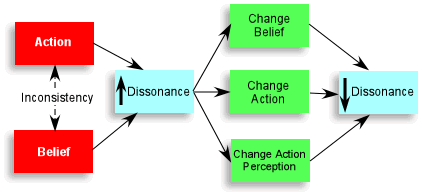For part one in which I define character arch and explain itâs importance, click here.For part two...

For part one in which I define character arch and explain itâs importance, click here.
Using Cognitive Dissonance to Define Character ArchWhat the H is Cognitive Dissonance
This is, simply put, the feeling all humans get when they are conflicted about themselves. The process starts like this: âI am x. Xâs cannot be Yâs, but I am also Y…wtf am I?â People do not like feeling cognitive dissonance. Itâs uncomfortable, and therefore itâs [basically proven] human nature to avoid or correct cognitive dissonance whenever possible. Let me give a quick example we can all relate to.
I like to write and consider myself a writer. I never write. Â
Those two thoughts about myself can exist at the same time, but I donât like it. I have a psychological need to git rid of one of them. The graph bellow demonstrates the choice I am now forced to make in order to alleviate this uncomfortable feeling of dissonance.Â

[I did not make this]
Using the previous example, my belief is that I am a writer. My action is that I donât ever write. My dissonance goes up. I have three choices.Â
A] I can change my belief about myself and accept that I am not a writer and I must not like writing because I never do it.Â
B] I can change the action, and write.Â
C] Or, I can change my perception of my action so it no longer upsets me, i.e. âI write when I have time and whenever I can even though thatâs not very often.âÂ
Any of these three bring down my dissonance.Â
How the H can I use this in my writing?If you have a well developed character, you should be able to fill out the first two squares. Now, the part that says âactionâ doesnât really have to be an action. It can be another belief, but most of the time it will be an action or a situation. âI am a writer. I had a stroke and now suddenly donât know how to physically write.â for example. The point is, within the scope of your story, you should be able to identify two conflicting situations your hero is in. The change that occurs within them [that forms the arch] can be any of the three green options.
Example
Hero believes he is a normal dope. But heâs called to action and has no choice because he is chosen, and it turns out he is quite special [conflicting action/belief/situation] Hero wonders, who the hell am I?Â
A) I guess Iâm not a normal dope after all. Consider my belief of myself changed.
B) Whoa, whoa, whoa. Iâm going back home to be a dope, this adventure is not for me. Goodbye conflicting action/belief/situation, Iâm not special
C) I am a normal dope at heart. Just because I have all these awesome powers doesn’t change that perception of myself.Â
So, this is a very simplistic story structure that I used as an example, and a very classic archetype. But this same principle can be applied to any character. This really helps when you find your character is faced with challenges in your plot driven story, but you donât really know how they are changing to overcome these obstacles. Often in plot driven stories, the characterâs change is necessary change [in order to defeat the big bad] and you as the writer might be creating this change without even realizing youâre doing it. Recognizing the ways your characters are changing is important because, by bringing out the most important and dropping more clues and drawing more attention to them for the reader, you can fully carve out your character arch within an otherwise plot driven story.



